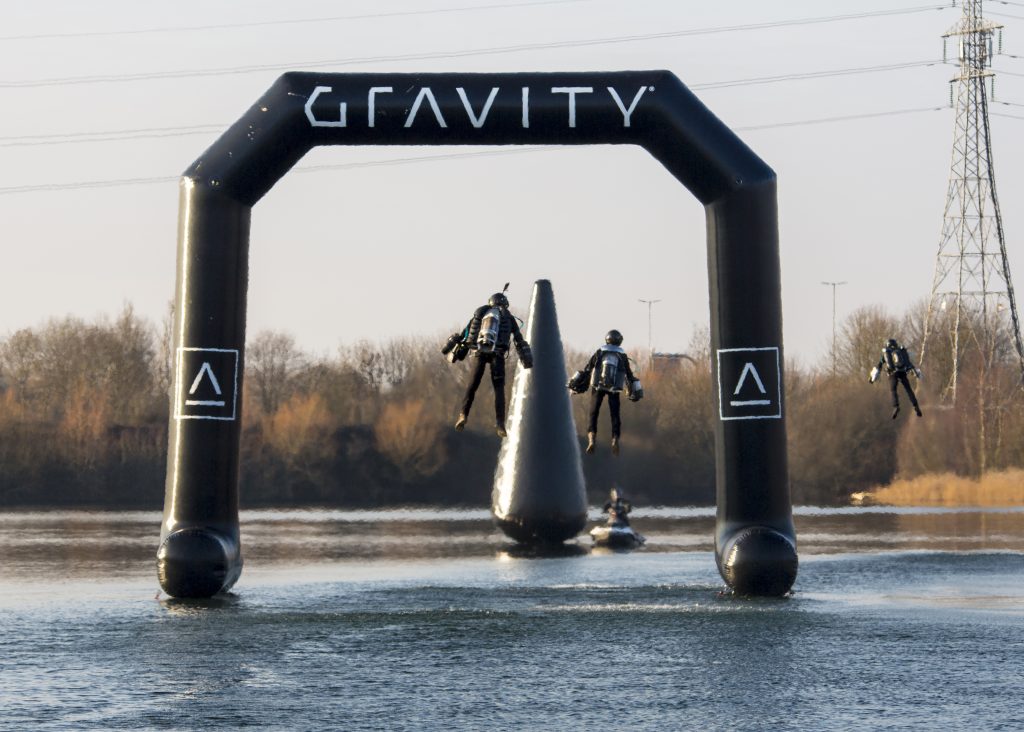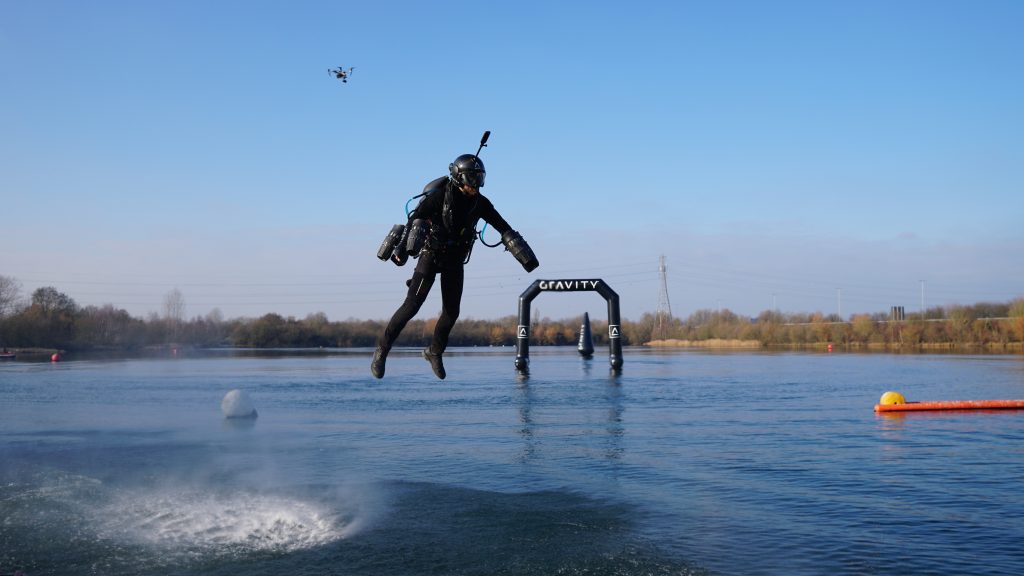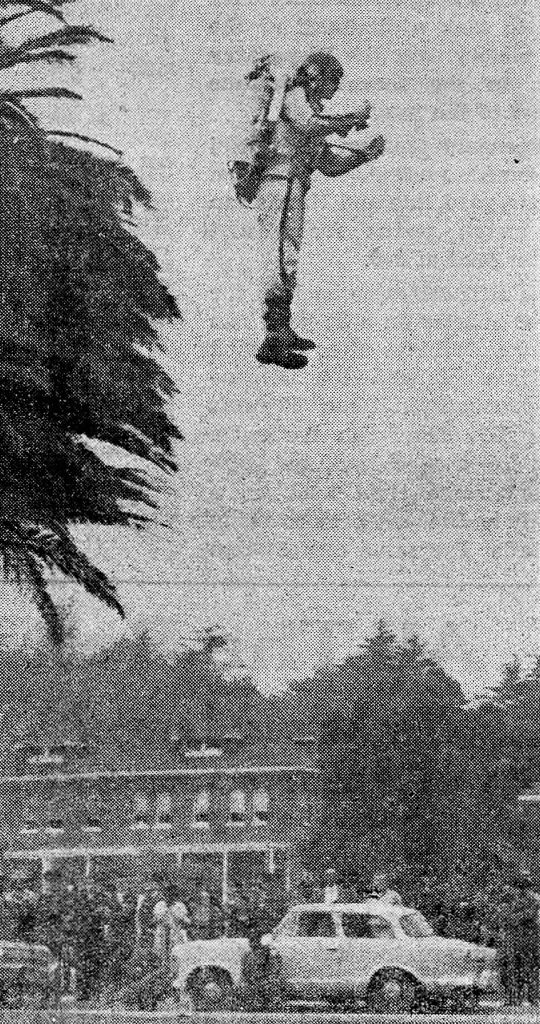The past and present of personal aerial mobility devices bridging sci-fi and reality.
Author: Ruth Euniki, Editor, and Naomi Lijesen, Final Editor
From James Bond to Tony Stark, superheroes often adorn this futuristic and far-fetched-feeling technology. But after a century of dreaming up designs, there are companies with practically perfect designs that show the impressive capabilities of jetpacks today.
FROM BACKPACKS AND ROCKETS TO BOOTS AND WINGS
It is not seldom that ingenious inventions are born from the simplest of questions. In this case: what will happen if you strap a rocket to your backpack and fire it up? It might seem like a thought one would have as a child when they are late for school, but it is also what made the Russian inventor Alexander Andreev come up with the first design for a personal flight device in 1919. Although the design was patented – an oxygen and methane-powered rocket system contained in a backpack – it was never prototyped or built.
Nearly four decades later, the idea came back to realization, this time by the American engineer Wendell Moore. Utilizing the designs made for the project ‘Himmelstürmer’ of the Nazi army, Moore and ‘Bell Aerosystems’ finalized and built the Rocket Belt. This first tested prototype of the modern-day jetpack completed its first free flight in 1961. The physics behind it took advantage of the catalysis of hydrogen peroxide with silver, creating a high-pressure stream that provided thrust to the configuration and could also be used for directional control. A simple and reliable design from the engineering perspective but a nightmare as far as the user experience was concerned: the Belt was heavy, loud, and very hard to maneuver. In the words of one of its few pilots, Bill Suitor, it was like “trying to balance while standing on a beach ball on the ocean”. The project was then brought to a stop since the US Department of Defense was unwilling to follow up on its initial $25,000 funding. Their interest remained. A few years later, they made a new attempt with the so-called Jet Belt (officially the WR19). It was an updated version of the Rocket Belt, where instead of using rockets for propulsion, it used small turbojets. The main disadvantages of the original Belt still persisted, leading to its discontinuation, but the engine technology was later implemented in a multitude of missile systems. [3]
In the meantime, the idea of a personal flying device became increasingly widespread in society, mainly through superhero fiction stories. The science fiction magazine ‘Amazing Stories’ (1928) and the black and white motion picture ‘King of the Rocket Men’ (1949) were two of the first instances where a jetpack was used to provide a character with superhero-like abilities. But what really captured the public’s attention was the real-life demonstration of Moore’s Rocket Belt in the James Bond movie ‘Thunderball’ in 1965. The imagination of media-makers took off, and different forms of personal flight devices started appearing in books, television series, and even video games. Boba Fett in the original Star Wars trilogy, G.I Joe, Buzz Lightyear in Toy Story, and the ‘Flash Liquidizing Ultra Dousing Device’ (or F.L.U.D.D.) in Super Mario are classic examples that are recognized even today.
The jetpack scene did not birth many new innovations for the next two decades. The action was mainly limited to the demonstrations and fine-tuning of the Rocket Belt. Of particular interest is the RB2000 model, a version developed in 1994 by Brad Barker, Joe Wright and Larry Stanley, three individuals with insurance sales, business, and engineering backgrounds, respectively. The new and improved Rocket Belt completed a successful 28-second flight in 1995. However, this story abruptly ended when it developed into an unsolved crime case: Stanley sued Barker for fraud, and Barker refused to pay the 10 million requested, Wright was murdered at his home, Stanley kidnapped Barker, who escaped after eight days, and Stanley was arrested in 2002 for his crimes. The RB2000? Never found. [4]
Whether it was because of the attention caused by the above case, or because of the general developments of society and technology, in the years following, jetpack developments started reappearing in the form of individuals or private companies with ambitious ideas. These were not limited to the traditional concept of a backpack or belt with a number of engines but experimented with a plethora of configurations. The Jet Wing of Swiss pilot Yves Rossy, for example, is a pair of 2-meter spanning wings with jet engines attached. With it, Rossy entertained the public with stunts and daredevils, such as aerial loops from a hot air balloon and a flight over the Grand Canyon in 2013 [5]. Franky Zapata took a different approach with the Flyboard Air in the late 2010s – choosing to attach the micro gas turbines to a board strapped on a pair of boots [6].
GRAVITY INDUSTRIES
As self-proclaimed pioneers of a ‘new era of human flight’, UK-based company Gravity Industries have certainly mastered the cool-ness factor that embodies our typical cinematic perceptions of jet suits (see Iron Man or Buzz Lightyear). Founder Richard Browning and his team of pilots include a range of stunt performers, Olympic athletes and professional helicopter and jet pilots. Since its launch in 2017, the company has set up search and rescue trials in the UK’s Lake District as well as military collaborations and continues to design, build, and fly its jet suits. They hope to unveil their International Race Series as a step into the sports entertainment industry soon.
The suit consists of five small gas turbine engines; one larger housed in a backpack and two smaller ones attached to each arm – see figure. For fuel, Gravity Industries uses Kerosine-type jet fuel Jet A-1 for its higher flash point, or premium diesel and the system attains 1050 bhp and 144 kg of thrust. It can achieve a flight time of up to eight minutes with a typical speed in excess of 60 km/h – assuming the pilot is no more than 85 kg and there are optimal conditions. As expected, controlling the system is notoriously tricky – which accounts for the physically fit team of pilots – and is handled by altering the direction of the arms. Naturally, there are many who would sell their soul for an experience like this, so at $8500 a pop, these instructions ensure the company’s success. They offer both flight experiences and flight training as part of their Flight Club from their base in Goodwood estate in Chichester, UK and Air7 base L.A. California. Willing daredevils must endure the considerable forces required to control the system and master their own vestibular system.

MAVERICK AVIATION
It seems the UK is a jetpack lover with yet another company entering the world of personal aerial mobility, this time from Southampton. Maverick Industries, founded in February 2020, offers “rapid access to inaccessible objects” in a hands-free configuration – made possible by its automatically stabilizing control system. Much like a Segway, directional flight is achieved by shifting one’s center of gravity so steering the suit is incredibly intuitive for wearers. Essentially, the control system uses software-controlled thrust vectoring, keeping the platform completely stable by combining several sensors in the control loop. It enables wearers to forgo the extensive and expensive training usually required with jetpacks – this is a first for the industry. Company CTO Matt Denton, has experience as a robotics and control engineer for movies such as Star Wars, Harry Potter and Jurassic World, and designed the system as a prototype for the UKs onshore and offshore energy industry [3]. With its four small gas turbine engines, each producing 300 N of thrust, in a square-type configuration, the system can achieve flight and directional control. However, two more are added for redundancy and extra lift. The top speed is 20 mph (32 km/h) for safety, but theoretically, it could fly as fast as 200 mph (322 km/h). Unsurprisingly, the flight time is hugely dependent on payload and air conditions, but it typically flies for a few minutes – enough to cover a few miles. A fascinating fact about this jetpack is the fuel type it runs on. Maverick Industries decided on the more sustainable option of Hydrotreated Vegetable Oil, a biodiesel produced by waste cooking oil from the catering industry. Furthermore, the jetpack also doubles up as a drone as it can fly autonomously to pick-up locations where users can clip in before heading off to tasks. The company has had a number of successful test flights in the concept demonstrator and continues to develop its prototypes.

WHY DO WE FLY?
Jetpacks are exceptionally cool – the technologies and people behind them push the limits of what we can do as human beings. However, unfortunately, they are wildly expensive to build and maintain – not to mention the costly and extensive training required. They are also infamously dangerous and have caused many injuries over the last few decades due to their unstable nature. So, why do we continue to design, build and better them? What functions do jetpacks have that drones, helicopters or other technology lack?
Firstly, jetpacks could allow us to move quickly and effortlessly across hostile terrains. Disaster zones – freshly ravaged by tsunamis, earthquakes, or hurricanes, are notoriously dangerous for humans to cover – yet we often must provide rescue and first aid in these territories. Where land vehicles cannot cross and bulky helicopters cannot land, the VTOL capabilities of jetpacks enable paramedics to respond quickly and provide emergency treatment that a drone simply could not. Gravity Industries have already exhibited this ability when conducting search and rescue trials in the UK’s Lake District. The mountainous area is beautiful but dangerous for hikers, and rescues are often lengthy if air and land ambulances can reach them at all. Their jetpack proved the efficiency of using this technology in such situations.
Another application of jetpacks would be within the engineering and maintenance sector. Infrastructure that is difficult to access can be safely and easily reached using jetpacks. External work on large substructures could be made significantly easier and simpler. If the difficulty of stability is solved, just as Maverick Aviation has seemingly achieved, it would allow engineers to fix and maintain infrastructure whilst hovering mid-air.
Jetpacks also have many potential uses within the armed forces – it is safe to assume there have been more than a few instances where they have contracted jetpack-type projects over the last few decades. They can be used for reconnaissance and other tactical transportation strategies, such as overpassing minefields. Most recently, Gravity Industries supplied the UK’s Royal Navy with a jet suit allowing them to maneuver from a rubber motorboat across a small stretch of open sea before landing safely on the HMS Tamar. Similarly, these suits could be potentially used for security and policing roles.

CONCLUSION
One reason we might is; simply for the fun of it! Flying when exposed to the elements in such a way is absolutely exhilarating. The fact that jetpacks have occupied our imaginations for many years reflects our delight in them. They are very entertaining, and now that the technology has progressed enough to ensure wearer’s safety, we may see considerably more recreational users in the future – that’s a lot of Iron Man suits.
REFERENCES
[1] Gravity Industries. Available: gravity.co/. [Accessed: 05-Dec-2022].
[2]“Personal Aerial Mobility Systems,” Maverick Aviation, 28-Aug-2021. Available: maverickaviation.co.uk/. [Accessed: 05-Dec-2022].
[3] Antony Quinn, “The fall and rise of jetpacks,” Royal Aeronautical Society, 16-Aug-2022. Available: aerosociety.com/news/the-fall-and-rise-of-jetpacks/. [Accessed: 05-Dec-2022].
[4] Dylan Thuras, “Where Eagles Dare: The Jetpack Murder”, Atlas Obscura, 26-Nov-2011. Available: https://www.atlasobscura.com/articles/jetpack-murder [Accessed: 05-Dec-2022].
[5] Jack Bailey, “Yves Rossy: The Swiss Pilot Famous For Jet Pack Flying”, Simple Flying, 05-Nov-2022. Available: https://simpleflying.com/yves-rossy-jetpack-flights-history/. [Accessed: 05-Dec-2022].
[6] Zapata. Available: https://www.zapata.com/en/flyboard-air/. [Accessed: 05-Dec-2022].



